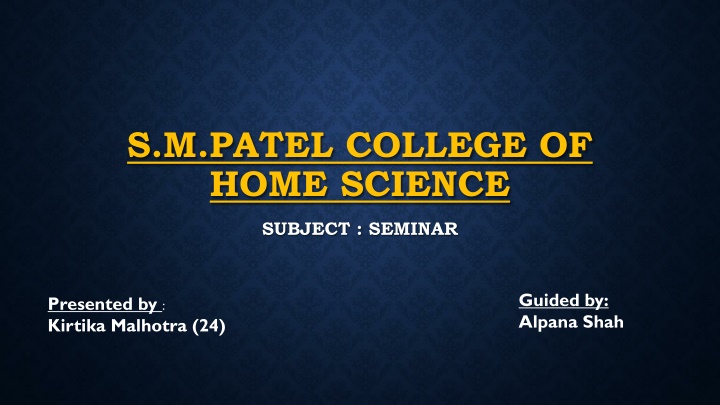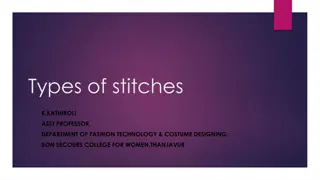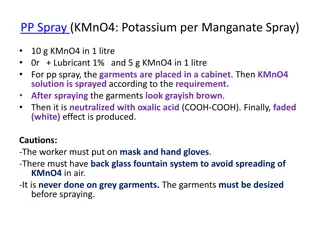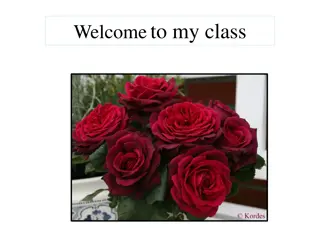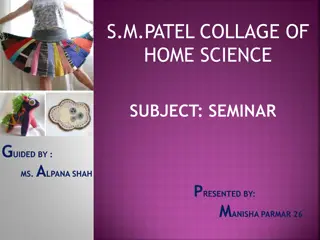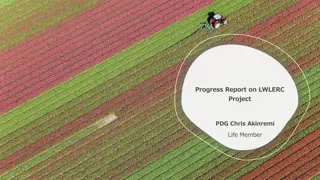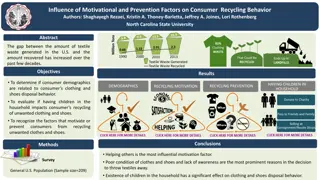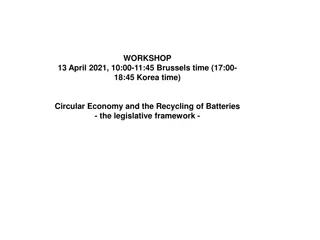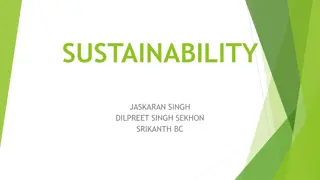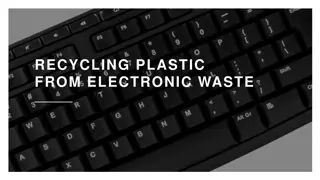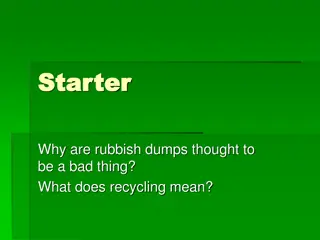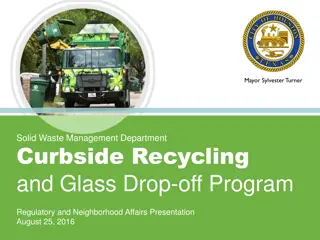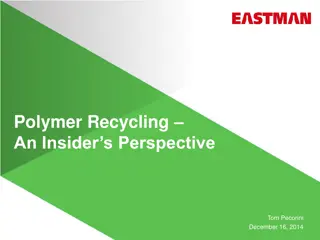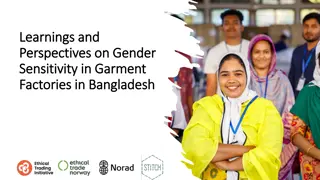Awareness and Techniques of Garment Recycling Among Housewives
This seminar conducted at S.M. Patel College of Home Science focused on studying the awareness of garment recycling and techniques adopted by housewives from different socio-economic backgrounds. The study aimed to promote the reuse and reprocessing of textiles to reduce waste. Through data collection and analysis, the research aimed to develop awareness and encourage the use of recycling techniques for socio-economic upliftment. Various papers were reviewed, highlighting the potential of traditional designs and methods to enhance garment value and productivity. The methodology involved area selection, data collection, and suggesting recycling techniques for value-added products.
Download Presentation

Please find below an Image/Link to download the presentation.
The content on the website is provided AS IS for your information and personal use only. It may not be sold, licensed, or shared on other websites without obtaining consent from the author.If you encounter any issues during the download, it is possible that the publisher has removed the file from their server.
You are allowed to download the files provided on this website for personal or commercial use, subject to the condition that they are used lawfully. All files are the property of their respective owners.
The content on the website is provided AS IS for your information and personal use only. It may not be sold, licensed, or shared on other websites without obtaining consent from the author.
E N D
Presentation Transcript
S.M.PATEL COLLEGE OF HOME SCIENCE SUBJECT : SEMINAR Guided by: Alpana Shah Presented by : Kirtika Malhotra (24)
AIM A study on the awareness of garment recycling and various techniques adopted by house wives of various socio-economic strata.
INTRODUCTION Garment/Textile recycling can be defined as the process of reusing or making new products from the waste materials. Textile recycling is a system of reusing or reprocessing or remaking the left over textiles used tops, saris, jeans, trousers etc. Approximately, 1.5 millions of textiles that we can reuse or recycle are unnecessarily put into the rubbish bins. Destroyed clothes may seem like trash, these fabrics can be reprocessed into rags and stuffing. Slashed ,sliced and shredded, the mills destroy the garments completely,reducing them to a tangled mess of fibres that can be transformed into yarns and woven into millions of blankets,shawls, and fabric in across South Asia.
OBJECTIVES To study the awareness of garment recycling. To collect information on recycling techniques adopted by house wives. To inculcate awareness for and use of recycling technique. To develop socio economic up gradation through recycling technique.
METHODOLOGY Identification and selection of area with different socio-economic strata through random sampling method. Collection of data to survey technique by questionnaire cum interview method. Analysis of the selected data. Suggesting and teaching technique for garment recycling to make them as value added products.
REVIEW OF LITERATURE 1) Value addition for knitted garments by Indian traditional designs. A paper presented by:- An Sai Krishnan , A Thirugnanasambantham and V Chandrasekaran on value addition for knitted garments by Indian traditional designs in the year June 2015. CONCLUSION:- hand printing and the traditional embroideries have potential to rejuvenate the time old rural crafts and can provide large scale employment to the artisans. 2) Improving apparel productivity through in house programme. A paper presented by:- Maged kamal, on Improving apparel productivity through in house programme. (In the year July 2014.) CONCLUSION:- which can be easily incorporated with available skills and equipment in industries The old ways of managing the maintenance function do not work any more. The use of everything from index,cards,peg board, and white board is cumbersome, in effective,and unreliable.
3) A study on knowledge of urban housewives about care and storage practices of clothes A paper presented by Sonu Mehta on a study on knowledge of urban housewives about care and storage practices of clothes . ( In the year April 2012) CONCLUSION :- The urban women have good knowledge of identification of fibers and fabrics and average in knowledge towards care and storage of clothes. Ultimately increases the life and quality of the garment and decreases the burden on budget at last.
Result In selection of recycling and various technique adopted by housewives of various socio-economic strata are :- 60% have 10,000 to 30,000 monthly income Monthly Income 20% 20% have 10,000 monthly income 10,000 - 30,000 10,000 30,000 - 50,000 20% 60% 20% have 30,000 to 50,000 income
90% of housewives are interested in learning skills for garments recycling. Learning Skills for Garment Recyclying 10% 10% of housewives are not interested in learning skills for garments recycling. Intrested Not Intrested 90%
Use of Worn-out Garments 40% of housewives sell it in place of vessels 60% of housewives use it as a duster 40% Use as Duster Sell it in place of Vessels 60%
40% of housewives take off the button from the old garments ,so it can be used in other garments Re-use of Garments 30% 30% 30% of housewives take out lace Lace Button Chain 30% of housewives take out chain from the garments like jeans ,cushion cover , suits etc. 40%
60% of housewives sell recycle garments Recycle Garments 40% of housewives do not sell recycle garments 40% Sell it Do Not Sell it 60%
90% of housewives are interested Learning of new technique of stiching of new article 10% of housewives are not interested 10% Intrested Not intrested 90%
20% of housewives gets their garments dyed Garments Dyed 20% 80% of housewives don t get their garments dyed Do Garments dyed Do Not Do Garments dyed 80%
FINAL SUGGESTION People utilized old jeans and pants to make things like 1. Doormats as shown in the picture.
2. Like vegetable bag:-
3. Even bandages are being reproduced with leftover white cotton fabrics
4. Old saris can be reuse in making doormats by hand knitting process.
Clothes which are not used can be reused as making quilts as quilting is an art of stitching layers of fabric together.
REFERENCES Asian Journal of Home Science [June 2015] ( page no: 107 to 109 ) Asian Journal of Home Science [ July 2014] ( page no : 99 to 103 ) Asian Journal of Home Science [ May 2013] www.picture-clothing .com www.garment waste.com
THANK YOU THANK YOU
